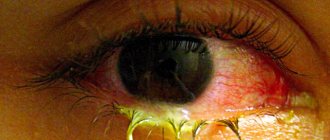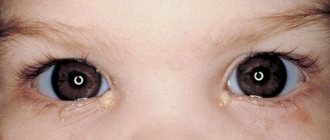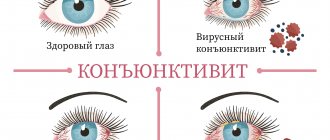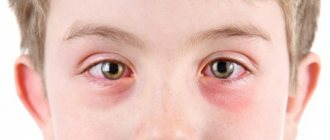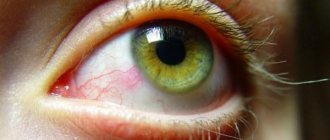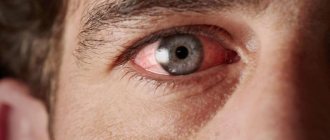Viral and bacterial diseases have an incubation period. This is the period of time that passes from the moment an infectious pathogen enters the body until the first signs of the disease appear. The duration of this period of time may vary. Consider the incubation period of bacterial conjunctivitis.
The concepts of “incubation” and “latent” are often confused. Let us explain the difference between them.
The latent period is the period of time from the moment of infection to the time when the patient becomes infectious to others. For example, when the influenza virus enters the body, a person becomes infectious a day earlier than the first symptoms appear, that is, the latent period is shorter than the incubation period.
When germs or viruses enter the body, they immediately begin to multiply, and the body reacts to such an invasion. The immune system is activated, the functioning of the respiratory organs, blood circulation, etc. changes. However, at the initial stage, all these reactions are expressed so implicitly that they can only be detected by special laboratory tests. Only after a certain period of time, that is, after the incubation period, the symptoms of the disease begin to appear.
When viruses enter the body, increased production of interferons begins. They belong to the group of cytokines - signaling proteins responsible for the interaction of cells with each other. Some of the cytokines activate or, conversely, or suppress their growth, others “control” different types of immune response. Interferons are proteins of general action. They do not work against a specific microorganism, but activate various immune cells - various killers and macrophages, which must cope with bacteria and viruses.
The duration of the incubation period can be a completely different amount of time, and this depends on several factors:
- general condition of the human immune system;
- presence of diseases;
- the number of pathogens entering the body;
- their virulence (reproduction rate);
- areas of introduction of viruses and bacteria;
- availability of vaccination against this disease.
The duration of the incubation period for different diseases differs, but in general it is characteristic of each of them. So, for flu and colds it usually ranges from several hours to three days, for infection with tetanus - from a week to ten days. In case of food poisoning, the reaction may occur after 2-3 hours, or maybe after 24 hours - it depends on the amount of product that enters the stomach and the speed of its digestion.
What influences the length of the incubation period?
The rate of spread of various infectious diseases depends on the length of time between infection and the onset of symptoms of the disease. So, the shorter it is, the faster the epidemic spread occurs. A person poses a danger to others, but he himself does not yet suspect it. The duration of the incubation period depends on the number of pathogenic microorganisms that have entered the body and the rate of their reproduction. At this time, the patient himself does not feel anything, but as the number of viruses or microbes increases, the body does not have enough strength to fight them on its own, and then signs of the disease begin to appear.
During the incubation period (not to be confused with the latent period), the sick person is not dangerous to others, although at this time it is already possible to detect the pathogen or antibodies to it in the body and begin therapy.
Features of the disease in newborns
Keeping an infant in sterile conditions and under constant parental supervision does not guarantee the absence of infection. The reasons for infection entering a small body also vary. The following factors can cause symptoms of the disease:
- Weakened immunity (in premature babies or children born with pathologies).
- Infection of the mother with the herpes virus.
- Passage through the birth canal infected with chlamydia or gonorrhea.
- Dacryocystitis (inflammation of the lacrimal sac, as a result of which the natural process of outflow of tear fluid is disrupted).
Another common reason is insufficient hygienic care for the child.
Bacterial conjunctivitis
Inflammation of the eyes of a bacterial nature if not treated in a timely manner poses a great danger to the body. The causative agents of bacterial conjunctivitis are various pathogenic bacteria: staphylococci, streptococci, gonococci, chlamydia, Pseudomonas aeruginosa and other microorganisms.
Even a newborn baby can get bacterial conjunctivitis if it is infected from a sick mother. When an infection occurs, the organs of vision turn red, the eyelids swell, purulent discharge appears, severe itching and irritation in the eyes. Some types of bacterial conjunctivitis in adults and children, such as gonococcal or chlamydial conjunctivitis, can cause severe, permanent damage to the eyes. If treatment of the disease is not started in a timely manner, it can become chronic, then the corneal tissues will suffer, keratoconjunctivitis, blepharoconjunctivitis will develop, scars will form, the cornea will become cloudy - this is what bacterial conjunctivitis can result from if treated carelessly.
Bacterial eye infections come in many varieties. Let's consider how long the incubation period lasts for conjunctivitis of various etiologies.
Preventive measures
In order to protect your child from the occurrence of conjunctivitis, you should follow simple preventive measures:
- Keep your baby's hands and nails clean. It is necessary to trim his nails regularly and teach him how to use antibacterial wipes on his own;
- promptly change the bedding in the child’s bed and regularly clean his toys;
- carry out wet cleaning of the children's room at least 3 times a week;
- daily ventilate rooms where the child spends a lot of time;
- if necessary, use air humidifiers in the nursery;
- ensure that the child’s diet is moderately fortified, healthy and moderate in calories;
- You need to walk with your baby at least 2 hours a day;
- even the smallest child should have his own personal towel;
- During an epidemic of conjunctivitis, you should try to avoid contact with sick children.
With the right and timely approach, any type of conjunctivitis can be eliminated quickly and easily. You should not risk your baby’s health and self-medicate. Only an ophthalmologist, who will select the necessary treatment, can determine and tell you how to properly treat conjunctivitis in children.
Fulminant bacterial conjunctivitis
This form of the disease is characterized by severe symptoms and rapid development. It is caused by the gram-negative diplococcus Neisseria gonorrhoeae, or gonococcus. The following symptoms are characteristic of fulminant conjunctivitis: swelling of the mucous membrane, copious purulent discharge. The standard incubation period lasts from 1 to 3 days. As a rule, the cause is gonococcal urogenital infection.
For fulminant bacterial conjunctivitis, treatment should be started as soon as possible, since infections caused by Neisseria gonorrhoeae severely affect the corneal tissue.
For this, various antibacterial drops and ointments are prescribed. To prevent gonococcal conjunctivitis, infants' eyes are washed with a 1% silver nitrate solution. You can also use drops with erythromycin or Povidone-iodine - it is also active against chlamydia, preventing the occurrence of chlamydial infection.
Basic rules of therapy
Treatment should only take place under the supervision of an ophthalmologist. It is better not to take any action until examined by a doctor. If a visit to a specialist is postponed, it is important to provide first aid. In case of bacterial or viral infection, you can inject a drop of Albucid into each eye. In case of allergic inflammation of the mucous membrane, an antihistamine should be given.
It is not recommended to use a blindfold, as it encourages the growth of bacteria and can injure sore eyelids. In case of allergic conjunctivitis in a child, it is forbidden to use rinses, which is recommended in the case of a viral or bacterial form.
When processing the visual apparatus, it is important to adhere to the following rules:
- use a separate cotton pad for each eye;
- Use only disposable napkins;
- cleansing movements should be directed from the outer corner of the eye to the inner;
- use medications prescribed by a doctor;
- If the inflammation affects only one eye, both need to be treated to prevent the spread of infection.
Additionally, it is necessary to monitor the child’s personal hygiene (regularly wash hands with soap, trim nails, etc.).
Treatment of eye conjunctivitis in children is selected individually by an ophthalmologist, taking into account the clinical picture and form of the disease.
Chlamydial conjunctivitis
Occurs when the eyes are damaged by chlamydia (a genus of bacteria from the class Chlamydiae). In total, several types of chlamydia have been classified that provoke a certain pathology: for example, trachoma, urogenital chlamydia, etc. The standard route of infection for chlamydial conjunctivitis in adults (almost 50%) is oral-genital contact. Chlamydia is transferred from the genitals to the mucous membrane of the eyes through hands or hygiene items: soap, towels. Often, ophthalmochlamydia can also be contracted through water when visiting public baths or swimming pools. This form is called “basin” conjunctivitis.
With this type of disease, the incubation period lasts quite a long time - from 5 to 14 days, only then the first symptoms appear:
- hyperemia and severe swelling of the conjunctiva;
- increased lacrimation;
- severe photophobia, pain when moving the eyeballs;
- swollen lymph nodes;
- hearing loss.
Eye inflammation caused by Chlamydiae is difficult to treat. The acute period can last from two weeks to three months. The fact is that chlamydia, although they are bacteria, have several properties inherent in viruses: small size, intracellular parasitism (that is, chlamydia itself cannot exist). In addition, chlamydia does not respond to antibiotics at all stages of its development, and they are ineffective against viruses. This series of properties, which bring chlamydia closer to viruses, complicates the efficiency of treatment.
In this case, immunity to the disease is not developed. It is also possible to become infected again from a sexual partner suffering from chlamydia, more than once. Some of the varieties of chlamydial conjunctivitis are quite dangerous for eye health. Thus, trachoma is the leading cause of blindness in the world caused by infection. Blenorrhea of newborns can also lead to loss of vision if not treated in a timely or competent manner. When chlamydial conjunctivitis passes into the chronic stage, the conjunctiva may thicken and large follicles appear in the lower eyelid. This form of the disease is also characterized by frequent blepharitis. Symptoms of diseases arising from chlamydia are similar to those of adenovirus infection. Only a specialist can make an accurate diagnosis. This must be done to prescribe the correct therapy.
Symptoms
Particular manifestations of conjunctivitis are determined by the reasons that caused its development. However, for all forms of inflammation, common symptoms can be identified:
- severe swelling;
- redness of the conjunctiva of the eye;
- mucous discharge from the eye;
- purulent discharge.
According to the course of inflammation, acute and chronic conjunctivitis are distinguished. Conjunctivitis can be infectious or non-infectious.
- Infectious conjunctivitis includes bacterial, viral, chlamydial and fungal conjunctivitis caused by the corresponding pathogen.
- Non-infectious are allergic conjunctivitis and inflammation of the eye mucosa caused by exposure to any chemicals or physical factors.
Symptoms of pink eye may vary depending on the type of conjunctivitis. If it is caused by a bacterial infection, then there are crusts on the eyelids and copious discharge from the eyes, which from time to time may acquire a greenish tint. The inflammatory process can spread to both eyes.
In the case of viral conjunctivitis, there will likely be swelling and hardening of the eyelids, and watery eyes with a small amount of discharge. In many cases, the process has a one-way course.
If the cause of conjunctivitis is an allergy, it is accompanied by itching, redness of the eyes and watery eyes. It is likely that along with this, nasal congestion and itching will be felt, and discharge will appear from the nasal passages.
Patients are concerned about swelling of the eyelids, redness of the eyes, burning, itching, lacrimation, sensation of a foreign body in the eye, discharge of various types - mucous, purulent, sometimes mixed with blood. The discharge causes eyelashes to stick together in the morning.
When the cornea is involved in the pathological process, patients complain of decreased vision. The general condition may also worsen: weakness, headache, and enlarged lymph nodes.
On examination, hyperemia and swelling of the conjunctiva are detected, there may be hemorrhages, follicles (rounded, raised formations, similar to bubbles, grains).
Of course, individual forms of conjunctivitis have their own characteristics.
Bacterial
Most often caused by staphylococci and streptococci. The cause may be dust, dirt getting into the eyes, or swimming in polluted waters. Bacterial conjunctivitis is characterized by purulent discharge from the eyes. Bacterial conjunctivitis can become epidemic, especially in children's institutions.
Pneumococcal
Features of pneumococcal conjunctivitis include: small pinpoint hemorrhages on the conjunctiva covering the sclera (the white of the eye), the formation of delicate whitish-gray films that are easily removed with a cotton swab, revealing loose, reddened, but not bleeding conjunctiva underneath.
Quite often, the cornea is involved in the inflammatory process, and small inflammatory foci appear on it - infiltrates, which subsequently disappear.
Pneumococcal conjunctivitis usually occurs against the background of acute respiratory viral infections and easily spreads among children, becoming epidemic in nature.
Acute epidemic
It occurs in outbreaks. It is highly contagious. Characterized by large and small hemorrhages on the conjunctiva, copious mucopurulent discharge.
Gonococcal
Or gonoblennorrhea is caused by Neisser's gonococcus. In adults and children, infection occurs when the infection is introduced into the eyes by hands from diseased genitals, through towels, and bed linen.
Gonoblennorrhea is especially dangerous for newborns. Newborn children become infected from a sick mother during childbirth when passing through the birth canal. Typically, both eyes are affected.
There is pronounced bluish-purple swelling of the eyelids. The child cannot open his eyes. Contents the color of meat slop are released from the palpebral fissure. The conjunctiva bleeds easily. After a few days, copious purulent discharge appears.
Severe swelling of the eyelids
With severe swelling of the eyelids, the blood supply and innervation of the cornea is disrupted, and newborns often develop a purulent corneal ulcer, in place of which a cataract subsequently forms, while vision is significantly reduced, up to complete blindness.
In adult patients, in addition to ocular manifestations, the general condition of the body is very serious. As a rule, in adults, gonococcal conjunctivitis occurs in one eye, but complications from the cornea are more common.
To confirm the diagnosis of gonoblennorrhea, a laboratory test of discharge from the conjunctival sac is performed to identify gonococcus.
Diphtheria
The causative agent of diphtheria conjunctivitis is diphtheria bacillus. Diphtheria conjunctivitis is characterized by hemorrhages and swelling of the conjunctiva with a bluish tint, the formation of gray films that adhere tightly to the mucous membrane, and when they are removed, the conjunctiva bleeds. In place of the films, star-shaped scars then form.
Viral conjunctivitis often occurs against the background of colds. In most cases, both eyes are affected. Viral conjunctivitis is characterized by mucous and serous discharge and the formation of lymphoid follicles on the conjunctiva of the eyelids.
Adenoviral
With adenoviral conjunctivitis, severe swelling of the conjunctiva and multiple follicles are observed. Often combined with catarrhal symptoms of the upper respiratory tract (pharyngoconjunctival fever).
The cornea is often affected with the formation of small, coin-shaped, very long-lasting infiltrates. Occasionally there are delicate thin, easily removable films on the conjunctiva.
Epidemic hemorrhagic conjunctivitis is caused by an enterovirus. A characteristic feature is multiple rather large hemorrhages (hemorrhages) on the conjunctiva of the eyeball and eyelids.
The eye looks like it's swollen with blood. The discharge is moderate, mainly at night and in the morning. First one eye is affected, and after a couple of days the second.
Allergic
Allergic conjunctivitis is a manifestation of the body's hypersensitivity to any substance. Often combined with allergic blepharitis, rhinitis, and skin rashes.
Allergic conjunctivitis can also be one of many manifestations of a systemic allergic reaction. Both eyes are usually involved. Characterized by severe swelling of the conjunctiva, burning, itching, and lacrimation.
- Seasonal and year-round allergic conjunctivitis are the most common types of allergic reactions in the eye. The first is often caused by tree or grass pollen, and as a result usually appears in the spring and early summer.
- Spring conjunctivitis is a more severe form of allergic conjunctivitis, in which the causative agent (allergen) is unknown. This disease is most common among boys, especially between the ages of 5 and 20 years.
Papillary
Giant papillary conjunctivitis usually develops in people who use contact lenses. Upon examination, growth of the conjunctiva in the form of papillae is revealed.
Hay fever
Hay fever is a seasonal allergic conjunctivitis. It worsens during the flowering period of grasses and trees that cause allergies. Often accompanied by nasal congestion.
Drug
It occurs quite often and usually develops within a few hours after taking medication (eye drops, ointments). Swelling of the conjunctiva, redness, itching, burning in the eyes, and copious mucous discharge rapidly increase.
Neonatal conjunctivitis
Ophthalmia of newborns (neonatal conjunctivitis, conjunctivitis of newborns) is, as the name implies, conjunctivitis that occurs in newborns. Any eye infection that occurs in the first month of a child’s life can be classified as ophthalmia of the newborn. The incidence of this disease in developed countries is 1-2%.
Neonatal conjunctivitis is most often caused by infection (bacterial or viral), eye irritants, or nasolacrimal duct obstruction.
The most common bacterial infections that can cause serious eye damage are gonorrhea (caused by Neisseria gonorrhea) and chlamydia (Chlamydia trachomatis).
They can be passed from mother to child during childbirth. Bacteria that normally live in the mother's birth canal can also cause conjunctivitis in newborns. If treated improperly or not, gonococcal conjunctivitis quickly leads to ulceration of the cornea and further perforation.
Viruses that cause genital and oral herpes can also be transmitted to the baby during birth and lead to the development of neonatal conjunctivitis and subsequent severe eye damage. However, this virus is less likely to cause this disease than gonorrheal and chlamydial infections.
Trachoma
Trachoma (granular conjunctivitis, Egyptian ophthalmia, inclusion conjunctivitis) is a leading infectious cause of eye diseases. It is a chronic keratoconjunctivitis caused by an obligate intracellular microorganism - Chlamydia trachomatis.
Trachoma
It is the leading cause of treatable blindness in the world, and one of the oldest diseases known to man. This disease occurs everywhere, but mainly in rural areas of developing countries. Trachoma often affects children, although the effects of scarring may not be noticed until later in life.
Initial symptoms of trachoma are relatively mild and include eye irritation and purulent or mucous discharge. However, repeated episodes of the disease can lead to progressive eye damage and eventually complete blindness.
Angular (angular) conjunctivitis
This type of eye inflammation has its own characteristics. It is caused by diplobacillus Morax-Axenfeld. During its course, the edges of the eyelids are noticeably affected, especially in the corners of the palpebral fissure. Signs of the disease are moderate conjunctival hyperemia, slight mucous discharge, and redness of the skin of the eyelids. The incubation period for bacterial angular conjunctivitis is 4 days. The first symptoms are burning and itching in the orbital area, then they are joined by pain and pain, especially intensifying when blinking. The eyes become red and swollen.
Conjunctivitis caused by the Koch-Wicks bacillus often occurs in epidemic form, especially in children's groups. Its incubation period is short - from several hours to 1-2 days. This eye pathology is also characterized by swelling and hyperemia of the conjunctiva, purulent discharge, and the disease is often accompanied by fever and headache. On average it can last up to 2-3 weeks.
General clinical picture
After the incubation period, the second stage of the disease begins, characterized by the manifestation of a pronounced clinical picture. The main symptoms of conjunctivitis in children are the following:
- Tearing. This symptom occurs in 98% of patients. It manifests itself most strongly in the first three days. Decreases at night or after instillation of drugs. The discharge from the eye is usually light or has a yellowish tint.
- Photophobia. Bright rays of light provoke pain and increase lacrimation. Children feel much better in the dark.
- Redness of the eye. The vessels located on the surface of the eyeball become very pronounced and redden. The eyes themselves look tired.
- Discharge of purulent secretion. This symptom does not always occur. It is characteristic of the bacterial form of the disease. The discharge of purulent secretion is observed throughout the whole day.
- Temperature increase. With a mild course of the pathology, there is a slight increase in temperature to 38 degrees. In severe cases, this figure can reach 39 degrees or more. Children become capricious and their general health deteriorates. Minor relief occurs only during daytime or night sleep.
- Foreign body sensation. Occurs in 80% of patients.
- Manifestations of an allergic reaction. Children develop a fever, runny nose or nasal congestion. When the disease is accompanied by atopic dermatitis, red spots may appear on the skin.
These are common symptoms of conjunctivitis. They may vary depending on the type of pathological process.
Viral conjunctivitis
Mention should also be made of such common types of eye inflammation as diseases of viral etiology. They account for approximately 85% of all cases of conjunctivitis in children and adults.
They arise as an independent disease and complication against the background of viral diseases: colds, flu due to contact with the mucous membranes of various viruses. Most often these are adenoviruses, which also cause inflammation of the upper respiratory tract - rhinitis, pharyngitis, tonsillitis, etc. Viral conjunctivitis in children often takes epidemic form, as it quickly spreads in children's groups through the air or contact. The child’s immune system is too weak to fully resist the action of pathogens.
Viral conjunctivitis has different incubation periods: from 8 hours to a week. When the first signs of pathology appear, you should immediately contact an ophthalmologist, who will prescribe the necessary medications.
It is the transmission routes that contribute to the rapid spread of viral and bacterial conjunctivitis.
Treatment with folk remedies
Our native traditional medicine offers a large number of recipes for the treatment of this disease. Treatment with folk remedies is carried out mainly using drops and lotions. Various herbs are used for cooking.
For bacterial or viral conjunctivitis, you can use cornflower tincture at home. One spoon of flowers is poured with a cup of boiling water and allowed to brew for 40 minutes. Next, the product is filtered. Use cotton pads soaked in the infusion to wipe your eyes.
You can also make rinsing baths. For this purpose, prepare 1 liter of infusion so that you can immerse your face in it and blink. Washing should be done four times a day. Course of treatment: one week.
The herb eyebright has a good effect in treating inflamed eyes. One spoon of crushed plant material is poured into 250 ml of boiling water, covered with a lid and allowed to brew for one hour. Next, the composition is filtered through two layers of gauze and used for eye lotions or rinsing before bed and in the morning.
In the treatment of the disease, the use of echinacea decoction for rinsing and lotions on inflamed and purulent eyes has shown good results. This plant has high anti-inflammatory, bacterio- and virusostatic properties.
For 200 milliliters of boiling water, take one spoon of crushed plant roots. Place on the stove, bring to a boil and let it brew for one hour. The decoction is used not only externally. It is very useful to take the decoction orally during conjunctivitis: two tablespoons five times a day.
Below we present several recipes from various herbs that are used to treat conjunctivitis in folk medicine.
- Compresses and eye washes from an infusion of dry aloe vera leaves. If fresh juice is used, it must be diluted 1:10 with boiled water.
- Rinse the eyes with infusion of marshmallow. The infusion is prepared as follows: in 1 glass of boiled water (cold), infuse 3-4 tbsp. ground root 8 hours. If boiling water is used, then pour 2 tbsp into a glass of water. marshmallow leaves or flowers.
- Infusion of hops and blueberries. It is done only for the new month. For a medicinal infusion, take equal parts of blueberry grass and hop cones. Add 1 tbsp to 1 cup of boiling water. composition of herbs, and infuse in a blanket for 1 hour. This solution is taken orally, 3 sips up to 4 times a day.
- Infusion of rose petals. For infusion, take 1 tbsp. petals (dry) and pour a glass of boiling water. The treatment solution is ready in 30 minutes. Afterwards, with the prepared infusion, they rub their eyes during the day, and at night I make compresses soaked in this solution on closed eyelids for 30 minutes.
- An infusion of several herbs: snapdragon, marshmallow root, black nightshade leaves. These herbs are crushed and infused with 0.5 cup of boiling water until cold. The filtered infusion is instilled 3 drops into the eyes once a day.
- Infusion of cornflower flowers. For infusion, take 1 tbsp. flowers and 1 glass of boiling water. This solution is ready in 30 minutes. The eyes should be constantly washed with the filtered solution.
Treatment with folk remedies is most effective with gradual alternation of several infusions, but you should not overuse a large number of infusions.
Aloe will help relieve inflammation and itching faster. Wash aloe leaves (5 pieces) well under warm water, grind in a meat grinder and squeeze out the juice. For 100 milliliters of juice, take 500 milliliters of warm boiled water and mix everything thoroughly.
Cotton swabs are moistened in this aqueous composition and applied to the eyes for 20 minutes twice a day. Conjunctivitis will go away very quickly.
You can apply fresh, pure aloe juice to sore eyes. 1 drop in each eye up to four times a day.
With purulent discharge
For purulent discharge from the eye, lotions should be made from a decoction of rose hips. For half a glass of water, take 1 teaspoon of crushed raw materials. Boil the product over low heat for 3 minutes. Then cover with a lid and let sit for another 10 minutes. Strain through three layers of gauze and use every hour.
For conjunctivitis, wild garlic is used. The fresh plant is crushed into a mushy state, the mass is spread on sterile gauze and applied to the inflamed eyelids for one minute. Such procedures are done up to three times during the day. The course of treatment is 4 days. You can also wash your eyes with juice and water diluted 1:1.
An effective ancient method of treating conjunctivitis is considered to be washing reddened eyes with purulent discharge with strong, warm brewed black (Ceylon) tea. For half a glass of boiling water, take 1 teaspoon of dry leaves. After four minutes, the tea is filtered and used as lotions and rinses.
An infusion of bay leaf will relieve redness, itching and discharge from the eye. For 100 milliliters of boiling water you will need one large leaf. Let the product sit for 15 minutes. Wash sore eyes 4 times a day.
The burning and inflammation of the mucous membrane of the eyes will go away if you eat fresh (or dried) blueberries every day. The dosage should be at least one tablespoon per day.
Our grandmothers treated conjunctivitis in children with cottage cheese. Fresh product should be wrapped in sterile gauze and applied to the eyes.
For conjunctivitis of a viral or bacterial nature, it is very useful to inhale garlic vapor after washing the eyes with herbal medicinal infusions. To do this, crush five cloves, bend over the garlic mushy mass and breathe in the fumes. The eyes should be wide open. Inhale through the nose and exhale through the mouth.
Aerogenic (airborne and dusty)
This is the fastest way to transmit infectious diseases from person to person or indirectly from contaminated air. Bacteria or viruses found in the upper respiratory tract are dispersed into the surrounding atmosphere in the form of small aerosol particles when sneezing. Moreover, the radius of spread of such an infectious “cloud” can reach two to three meters around the patient. For example, viruses can remain suspended in the air for quite a long period of time, and also move in the atmosphere - this is possible due to the presence of an electric charge and Brownian motion.
As soon as a healthy person inhales air with a suspension of microbes or viruses, infection occurs in almost 100% of cases. At the same time, the incubation period for bacterial and viral conjunctivitis can last differently: it depends not only on the type of disease, but also on the person’s health status, age, vaccinations and other factors. Everyone's immune system is different. For some people, a very small amount of germs is enough to become infected. And someone, on the contrary, is present in public places during seasonal epidemics, while remaining healthy. However, doctors recommend wearing protective masks outside the home during especially dangerous periods of flu and colds to protect yourself from the risk of accidental infection.
Many adenoviruses are unusually tenacious and can remain active on dirty and dusty surfaces for up to 7-10 days. If, when inhaling, such dust particles fall on the mucous membranes of the eyes, then infection occurs. Adenoviruses die only when heated to 56 degrees, treated with chloramine or ultraviolet light.
Elimination of the allergic form of the disease
In case of an allergic form, it is first necessary to identify the irritant and try to eliminate its negative impact on the body. Therefore, in addition to an ophthalmologist, an allergist may be involved in treatment.
It is not advisable to rinse your eyes, as the risk of complications of the disease increases. The following antiallergic drops are considered the most effective: “Allergodil”, “Olopatadine”, “Lecrolin”. If urgently necessary, treatment can be supplemented with hormonal agents. Symptoms should not be ignored for a long time or treatment of allergic conjunctivitis in a child should not be neglected. Its advanced form can lead to bronchial asthma.
Contact-household method
Bacteria are also easily transmitted through direct contact between people (handshake, kiss, sexual intercourse) or indirectly through shared objects - dishes, hygiene items, etc. It’s not for nothing that bacterial conjunctivitis has another name - “dirty hands disease.” As soon as you touch an infected surface or thing, say hello to the carrier of the virus, and then touch the mucous membrane of your eyes with your hands, in most cases, infection with various types of conjunctivitis occurs.
The routes of transmission of infection make it clear why viral and bacterial diseases often take an epidemic course, especially among preschool children. Children in kindergarten constantly use shared toys; they may wipe their hands with one towel or not wash them after a walk if the teachers do not supervise this. Due to poor personal hygiene, as well as weak immunity, children under seven years of age often suffer from conjunctivitis. Doctors say that a child who has never experienced eye inflammation before the age of seven is truly rare.
If an epidemic occurs in a team, a quarantine is declared, which can last up to 14 days. The premises undergo thorough sanitary and hygienic treatment of all surfaces with disinfectants. Sick children remain at home during this time until complete recovery. During the treatment period, it is important to follow some rules that will help quickly eliminate the symptoms of eye pathology.
general characteristics
How does conjunctivitis manifest?
Conjunctivitis (sometimes misspelled as conjunctivitis) is an inflammatory disease of the conjunctiva, the thin transparent tissue lining the inner surface of the eyelid and the visible part of the sclera, which has an infectious or other etiology.
What does eye inflammation lead to?
The inflammation causes the small blood vessels of the conjunctiva to become more visible and the white color of the sclera to take on a pink or red tint, which is why the condition is often called “pink eye.”
Some forms of this disease can be highly contagious and spread easily. Although infectious conjunctivitis is not usually considered a complex eye disease, it can sometimes lead to more serious consequences.
The most common causes of conjunctivitis are viruses, bacteria and allergens. But there are other factors that cause this disease, including chemicals, fungi, certain diseases, and the use of contact lenses (especially extended wear).
Irritation of the conjunctiva can also occur when foreign bodies enter the eye, upon contact with air contaminated, for example, with chemical vapors, gases, smoke or dust, both indoors and outdoors.
The eyes of newborns are susceptible to bacteria that are normally present in the mother's birth canal. These bacteria cause no symptoms in the mother, but in rare cases can cause infants to develop a severe form of conjunctivitis known as ophthalmia neonatorum.
Hygiene requirements for the treatment of infectious diseases
When carrying out therapeutic therapy, it is important to strictly observe the rules of personal hygiene - this largely determines how quickly conjunctivitis can be cured. For a sick person, you need to have a separate towel and soap, and change bed linen more often, especially pillowcases.
Infections, as a rule, begin to develop when the immune system is weakened, so during the period of illness it will be useful to take a course of vitamins that are beneficial for eye health. Your diet should include foods rich in vitamins A, B, C, selenium, zinc, lutein, and zeaxanthin. You should limit the consumption of fatty, spicy, smoked foods, nicotine, and alcohol.
During treatment, it is better to stay at home, refusing to visit public places, swimming pools, solariums and other establishments where there are a large number of people. Following these simple hygiene and safety rules will help eliminate the symptoms of bacterial or viral conjunctivitis as soon as possible.
Rules for caring for patients
Regardless of whether the patient was diagnosed with viral or bacterial conjunctivitis, it is worth understanding that this is an infectious disease, and pathogenic microorganisms can spread quickly. That is why you need to follow some precautions.
If possible, a sick patient should be isolated from contact with others. For example, if a child has been diagnosed with bacterial conjunctivitis, then for the duration of treatment you need to refuse to attend kindergarten, school and other institutions.
The patient must provide his own dishes, towels, and bed linen. Clothing and other textiles that the patient comes into contact with should be changed daily and washed at high temperatures.
To apply drops or ointments, you need to use disposable sticks or pipettes. If reusable devices are used, they must be sterilized regularly.
Patients are advised not to wear contact lenses during therapy. It is necessary to ensure the sterility of optics, containers and solutions for storing lenses.
The infection often spreads from one eye to the other, so both eyes need to be treated with medications.
After contact with the patient, it is recommended to wash your hands thoroughly.
Consequences of late treatment
Conjunctivitis, if you do not consult a doctor in a timely manner and start taking medications late, can take a chronic course. In this case, the treatment process will take much longer. When the first signs of illness appear, you need to contact a specialist, and not look for advice on online forums. With improper therapy, inflammation can intensify, which poses a danger to the organs of vision, as eye tissue will be damaged. Only a specialist can correctly determine the type of conjunctivitis after receiving tests and prescribe effective medications taking into account the patient’s age. During the treatment period, careful compliance with all recommendations is required. There is no need to exceed the dosage of drops and ointments at your own discretion; use them strictly according to the prescribed regimen.
If improvement in the condition of the eyes does not occur within 2-3 days, then you need to consult a doctor again, he will change the medicine. Taking antibiotics for too long leads to a weakened immune system and the development of superinfection—the growth of a different type of bacteria than the one that caused the disease. Only careful attention to your health will help you keep it in order.
Diagnostic measures
As a rule, a general examination of the patient by the doctor is enough to determine the presence of conjunctivitis. In the future, the specialist will definitely collect information for anamnesis (for example, it is important to determine whether the development of the disease is associated with an allergic reaction, etc.). Diagnostics also includes some procedures.
Biomicroscopy of the eye is informative, which involves examining the organ using a special slit lamp. During the procedure, the doctor can detect the presence of foreign bodies or inflammation in the eye, assess the depth of the pathological process, examine the conjunctiva, iris, cornea, lens, and fundus.
A swab is also taken from the conjunctiva. The obtained samples are used for bacteriological culture. This procedure lasts several days, but allows you to accurately determine the causative agent of inflammation (or pathogens), as well as check the degree of their sensitivity to certain drugs.
Is it possible to go for a walk?
During the height of the disease, it is better to limit walking. Doctors recommend waiting a few days until you feel better. With fever and severe lacrimation, walking in the fresh air can even be dangerous. The thing is that the mucous membrane is very sensitive to various irritants. Sun rays can damage your eyes and increase tearing.
After the main symptoms subside, you can safely go outside. It is better to use sunglasses for the first few days. For newborns, preference should be given to a stroller with a large canopy. If you walk in the summer, be sure to wear a wide-brimmed hat. Baseball caps are also suitable, as they provide shade on the face and protect the eyes from direct sunlight.
How to properly apply eye drops to a child?
Treatment of conjunctivitis in children usually involves the use of drops. During the procedure, it is unacceptable to shout at the child when he squints or turns away. This is a natural defense; it can be quite difficult for a baby to control himself.
To facilitate this process, doctors give the following recommendations:
- If the child is afraid and closes his eyes, it is enough to drop the medicine between the eyelids. After opening the eye, it will be evenly distributed throughout the mucous membrane.
- Do not rub or smear the drug.
- To avoid accidental damage to the conjunctiva, it is necessary to use a special pipette with a rounded end.
- Excess medicine can be blotted with a sterile cloth.
- It is better to teach older children to instill the drug on their own, but under the supervision of their parents. Some people simply don't like people touching their eyes.
Before use, the bottle with drops from the refrigerator must be rubbed in your hands. It is not recommended to use the drug after its expiration date or when stored open for a long time.
